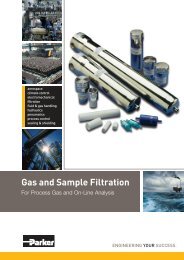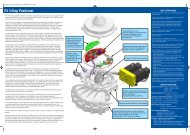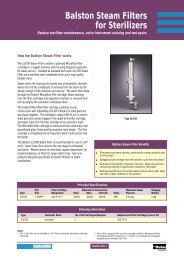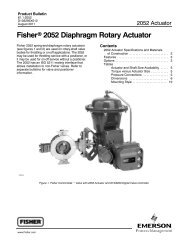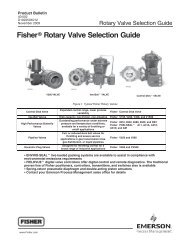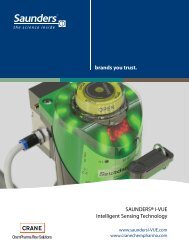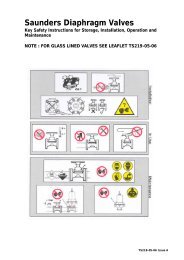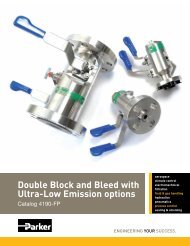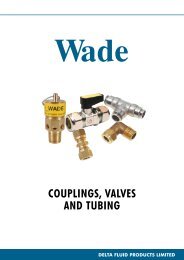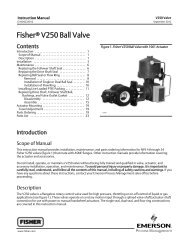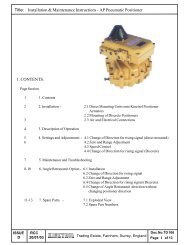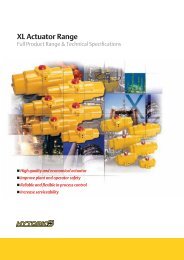Fisher® FIELDVUE DVC6200 Digital Valve Controller
Fisher® FIELDVUE DVC6200 Digital Valve Controller
Fisher® FIELDVUE DVC6200 Digital Valve Controller
Create successful ePaper yourself
Turn your PDF publications into a flip-book with our unique Google optimized e-Paper software.
Instruction Manual<br />
D103605X012<br />
Glossary<br />
July 2012<br />
HART (acronym)<br />
The acronym HART stands for Highway<br />
Addressable Remote Transducer.<br />
HART Universal Revision<br />
Revision number of the HART Universal<br />
Commands which are the communications<br />
protocol for the instrument.<br />
Input Characteristic<br />
The relationship between the ranged travel and<br />
ranged input. Possible values include: linear,<br />
equal percentage, and quick opening.<br />
Input Current<br />
The current signal from the control system that<br />
serves as the analog input to the instrument. See<br />
also Input Signal.<br />
Input Range<br />
The analog input signal range that corresponds to<br />
the travel range.<br />
Input Signal<br />
The current signal from the control system. The<br />
input signal can be displayed in milliamperes or in<br />
percent of ranged input.<br />
Instrument Level<br />
Determines the functions available for the<br />
instrument. See table 5‐1.<br />
Instrument Mode<br />
Determines if the instrument responds to its<br />
analog input signal. There are two instrument<br />
modes:<br />
In Service: For a fully functioning instrument, the<br />
instrument output changes in response to analog<br />
input changes. Typically changes to setup or<br />
calibration cannot be made when the instrument<br />
mode is In Service.<br />
Out of Service: The instrument output does not<br />
change in response to analog input changes<br />
when the instrument mode is Out of Service.<br />
Some setup parameters can be changed only<br />
when the instrument mode is Out of Service.<br />
Instrument Protection<br />
Determines if commands from a HART device can<br />
calibrate and/or configure certain parameters in<br />
the instrument. There are two types of<br />
instrument protection:<br />
Configuration and Calibration: Prohibits changing<br />
protected setup parameters; prohibits<br />
calibration.<br />
None: Permits both configuration and calibration.<br />
The instrument is ”unprotected.”<br />
Instrument Serial Number<br />
The serial number assigned to the printed wiring<br />
board by the factory but can be changed during<br />
setup. The instrument serial number should<br />
match the serial number on the instrument<br />
nameplate.<br />
Leak Class<br />
Defines the allowable leakage by a valve when it is<br />
closed. Leak class numbers are listed in two<br />
standards: ANSI/FCI 70‐2 and IEC 534‐4.<br />
Linear<br />
A valve flow characteristic where changes in flow<br />
rate are directly proportional to changes in valve<br />
stem travel. One of the input characteristics<br />
available for a <strong>FIELDVUE</strong> Instrument. See also,<br />
Equal Percentage and Quick Opening.<br />
Linearity, dynamic<br />
Linearity (independent) is the maximum<br />
deviation from a straight line best fit to the<br />
opening and closing curves and a line<br />
representing the average value of those curves.<br />
Memory<br />
A type of semiconductor used for storing<br />
programs or data. <strong>FIELDVUE</strong> instruments use<br />
three types of memory: Random Access Memory<br />
(RAM), Read Only Memory (ROM), and<br />
Non‐Volatile Memory (NVM). See also these<br />
listings in this glossary.<br />
Menu<br />
A list of programs, commands, or other activities<br />
that you select by using the arrow keys to<br />
highlight the item then pressing ENTER, or by<br />
entering the numeric value of the menu item.<br />
93



